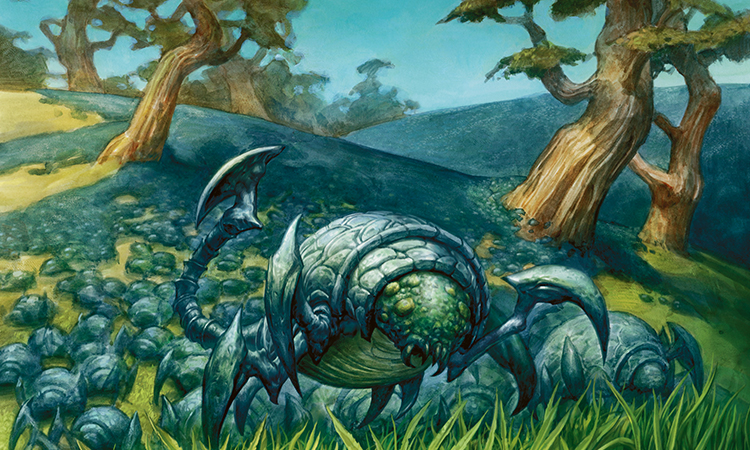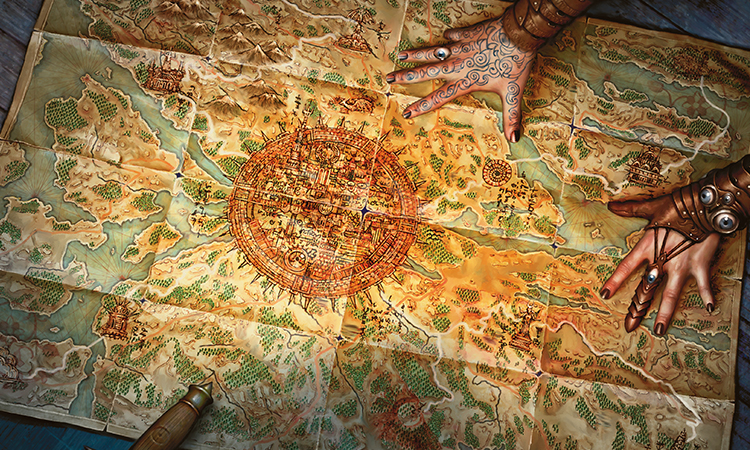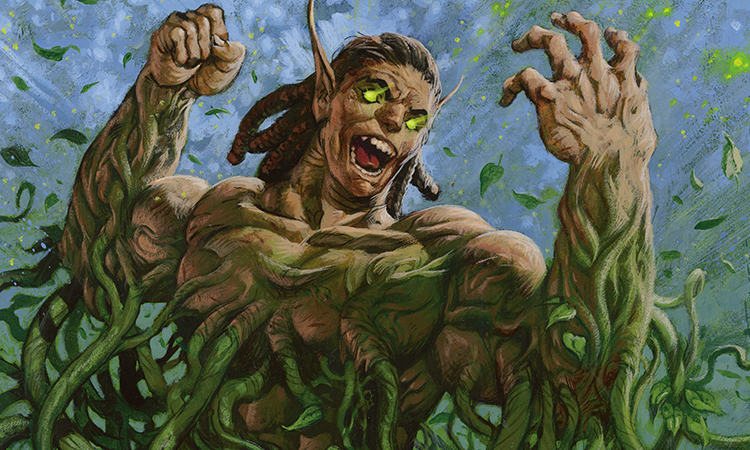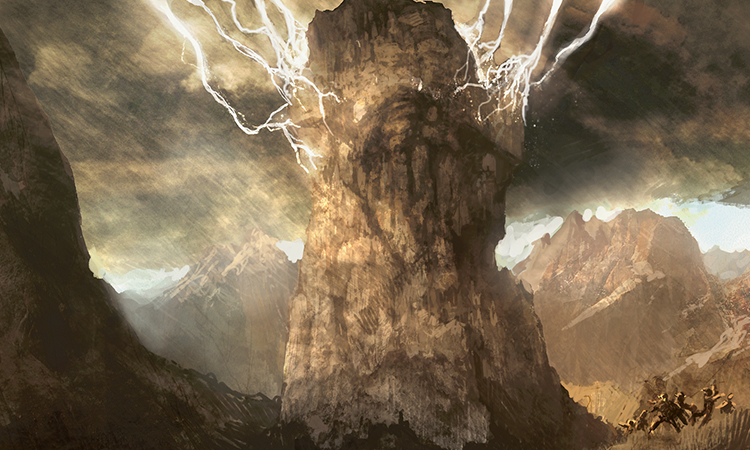A Moment of Doubt
Welcome to Land Week! In honor of Battle for Zendikar and its strong land themes, this week we're talking all about the one card type that goes in (just about) every deck—land. Now, I've had numerous land-themed weeks before:
- In March of 2003, we had Non-Basic Land Week and I wrote an article all about the rules of designing lands in an article called "This Land is My Land."
- In February of 2009, we had Domain Week and I wrote about a non-basic land that we've tried and failed to design for years in an article called "Whatever Happened to Barry's Land?"
- In March of 2009, we had Mana Fixing Week and I wrote an article all about spells that helped get you lands and mana called "Mana with All the Fixin's."
- In May of 2011, we had Mana Week and I wrote an article about why Magic's mana system, as it is, is so important to the game in an article called "Mana Action."
So I've talked a lot about land and mana. I've decided instead to take Land Week and go in a very different direction with it.
I've written over seven hundred Making Magic columns and I've shown many emotions along the way, but one emotion I don't think I show very often—and something that's a big part of the creative process—is doubt. Today's column is all about a time when I almost caved into doubt, and the Zendikar set came close to never existing. It's Land Week, so let's explore how the "lands matter" theme was almost discarded.
We'll Find Land
This story begins with a meeting with my former boss, Randy Buehler (whose position is now filled by Aaron Forsythe). Randy had been tasked by his boss—Bill Rose, the VP of R&D—with figuring out what the future of Magic looked like. Randy came up with the idea of creating something he called the five-year plan. I would come up with a rough idea for five blocks that I would flesh out, and then once Randy and I were in agreement, he'd pass it along to Bill.
This was back in the day when blocks were about themes, so I knew we were going to do another multicolor block and an artifact block and a tribal block. But I knew that if all we ever did was revisit popular themes we'd done before, we were going to lose touch with our ability to do new and cool things. Magic is a game about exploration, which means we have to be willing to brave out into new design territory.
The best idea I had at the time was this idea that had been tickling the back of my brain. Lands were core to the game and every deck had to play them (okay, almost every deck). It was a theme that we'd spent very little design time looking into. My gut said that there had to be a rich vein of design there.

Scute Mob | Art by Zoltan Boros & Gabor Szikszai
A quick aside on my gut: I'm a very intuitive person. I have an inkling of what to do long before I intellectually understand why I'm drawn towards a certain course of action. This intuition has proven so useful that I have adapted to it. I am used to following my intuition, my gut, without concrete reasons. I know that along the way it will all become clear to me and that I'll be happy. In general, in my life, this intuition has served me very well, so I've learned to trust it implicitly. So when I say my gut felt something, that means I was all-in on whatever my gut was saying.
Randy didn't see what I saw, but he trusted me. He agreed with my philosophy that we should be pushing towards things we haven't done and have what he called "experimental blocks." The five-year plan ended up becoming a six-year plan, and the final year was listed as "Experimental Design Block."
Land's Ahead
The six-year plan got presented and everyone liked what they saw. Well, except the final year. " 'Experimental Design Block,' what's that?" I would start to explain my vision for a block with a focus on land, and Randy would always interrupt me and explain that Magic has gotten to where it has by stretching and trying new things. I was a visionary and had ideas that weren't fleshed out yet, but it was crucial to allow me the chance to explore and discover new untapped design space. Everyone liked what Randy was saying and said okay.
As the years rolled by, I was often asked about the Experimental Design Block. But whenever I would start into my talk about my vision for a land-focused block, people would get a look. It's the look where they're trying to be polite, but they have no interest in what you are selling them. Sometimes the look turned into words and it would always begin with, "So what else do you have?"
I was steadfast in my vision and I had promises from Randy that I was going to have a chance to attempt the Experimental Design Block my way. And then Randy left and Aaron took over for him. Aaron had done a lot of design with me over the years and he had seen me come up with ideas that others had dismissed (such as the 4/3/3 guild structure of the original Ravnica block) and had learned like Randy to trust me. Aaron wasn't completely sold on my land block idea, though.
Eventually it became time to start the design of the block. Bill pulled me into his office. Now, Bill and I go way back. He and I started in R&D in the same month (October of 1995). There are few people in all of Wizards with more faith in me than Bill. He and I have been through a lot together. It was me and Bill by ourselves, for example, who convinced the rest of the company that split cards were a good idea in Invasion. (For more on that story, read here.) So it was very hard when Bill started off the meeting by saying "Mark, I don't believe in this idea."
"No one else in the company believes in this idea. No one else in R&D shares your vision about this idea. No one in Brand has any faith in this idea. You are completely alone. But, I believe in you. Time and time again you have proven that you can take ideas no one believes in and make them work, so here's what we're going to do. I'm going to give you two months. Work with your team and produce something. You have two months to convince me that you have a good idea. You can't just tell me though, you have to show me. I have to see the bare bones of what the set is going to be. If you can convince me, I'll help you convince everyone else. But at the end of the two months, if I'm not convinced, the set's going to change."
Bill had given me a very fair deal. I had two months to put up or shut up. I had basically taken all my internal political capital and shoved it into the middle of the table. I was all in. And all of this was based on my gut.

Expedition Map | Art by Franz Vohwinkel
A Rough Landing
I assembled my design team (myself, Doug Beyer, Ken Nagle, Graeme Hopkins, and Matt Place). Our mission from day one was very clear: Let's find some good land mechanics. Now, I wasn't starting from scratch. I had a few interesting leads.
One of the things I was very eager to explore was the idea of a card that could be either a spell or a land. It was a spell when you wanted it or a land when you needed it. Many years earlier, Brian Tinsman had created landcycling—spell cards that you could spend mana and discard to go search for a particular basic land. Shards of Alara block, the block preceding Zendikar block, had just made use of landcycling and had even introduced basic landcycling. That was off the table.
Okay, let's approach the problem from the opposite end. What if you had land that could essentially turn into a spell when you needed it to be one? After a little testing, the answer seemed to be a land that had an enters-the-battlefield effect that required a mana cost. For example, imagine an Island that entered the battlefield tapped, but if you spent 3U, you could draw two cards. Basically it was a card drawer that could also be a source of blue mana when you needed it. That seemed very cool.
But in playtesting, what we found was that people treated them like lands for deck building and like spells for gameplay. You would put the card-drawing card in your deck as one of your lands, but then when you drew it, you were heavily encouraged not to play it—especially if you were close to casting it. The design team figured out that you had to treat these cards not as land but as spells, and then if you had enough of them, you could cheat a little on land. Also, it required you playing the land when you needed land and ignoring the lure of the spell. Okay, you just had to adjust to how to use them and then they were fun.
In the back of my head, though, I knew there was a problem. Mechanics that lead players to play them incorrectly are endemic of bad design. We playtested with the more casual players in the building, and they routinely got it wrong. But it was worse than that. The games it led to were awful, because new players were mana screwed every game. We had made a mechanic that trapped people into playing the worst part of the game—the part where you never get to do anything and helplessly lose as your opponent runs over you.
We also played around with the land drop as a cost. What if a spell was much cheaper than normal and the additional cost was you had to use your land drop for the turn? The problem we quickly ran into is that the times you want the cheaper spells are the same time you really need to be playing land, so we had a similar thing happen during playtesting: Players who opted to use the mechanic had a slower mana development and tended to get beaten by the players with more mana. The correct call was to stop putting the mechanic in your deck.
We then tried a kicker variant where the land drop didn't make it cheaper but increased the effect. We assumed early in the game you'd cast the cards for their smaller effect and later when you didn't have land to play, you could get the free upgrade. In playtesting, we found players were greedy and kept upgrading the spells even when they really needed the land development more.
We tried mechanics that just went on lands. We tried mechanics that counted lands. We tried mechanics that sacrificed lands. We spent the first six weeks of design trying 40 different land mechanics. And every one, for some reason or another, wasn't working.

Vines of Vastwood | Art by Christopher Moeller
Land Slide
I'd put a lot on the line. Being Head Designer is tricky business. It's my job to convince others to follow me down paths that aren't very clear. Having the trust of the rest of the department (let alone other departments) is crucial. I was so sure that this idea was good that I'd bet everything on it. And things weren't working out. When we tried every potential mechanic I saw, they took us down rabbit holes that got us into trouble. Messing with land is tricky, because it can encourage players to do things that lead to bad gameplay. Time was running out and I didn't yet have what I needed to prove to Bill that a land-focused block was a good idea.
This story all leads to the moment I wanted to talk about today. It wasn't a public moment. It wasn't something my design team ever saw, but it was a very memorable moment for me in my career at Wizards of the Coast. I came home one day with my shoulders sagging low. I remember asking my wife, did I make a mistake? Was my gut wrong? Did I gamble everything in a place that I shouldn't have?
I bring this up because I think too often I gloss over the tough aspects of the job and skip to the "and then it worked out" part of the story. Creative work is hard; you're making something out of nothing. It requires you taking a lot of educated guesses and doing the best you can. Things don't always work out, and sometimes plans change.
This article came about because I was talking with someone about the creative process and they said, "How come it's so easy for you?" I replied that it's not easy and they said, "You always make it sound like it is."
In trying to create excitement for the new set and tell fun stories, I often leave out some of the uglier truths. Zendikar was one of my biggest successes, but for a moment it looked to be my greatest defeat. Things don't always run smoothly, and even the best of sets has bumps along the way. I'm a very optimistic person and, in general, I believe that with enough work my design team will find the right answer. But I too have my moments of doubt.
I say this because I think it's important for everyone out there doing their own creative things, who may be having problems realizing their particular visions, to realize that these challenges are universal. If you dig down deep, every artist has problems. Everyone has doubts. Everyone has had many moments where their vision faltered or their idea just didn't turn out the way they thought it would. The art of creation is a messy business and, at times, it can be really hard.
I don't simply understand your pain; I've experienced it myself. That day I came home during Zendikar design, I questioned everything. I doubted everything. I felt as if I had failed. There was moment where I was convinced that I had made a huge mistake and that maybe, just maybe, we should dispose of the whole land-focused theme.

Burst Lightning | Art by Vance Kovacs
Land Ho
After much soul searching that day, I came to the following conclusion. I had always trusted my gut. I had two weeks left. Maybe at the deadline I would fail, but it wouldn't be because I hadn't spent every moment trying. Let's wait to worry about failing until after I failed. My team and I believed in the idea. Let's make it work!
That week we came up with landfall. We also found a way to make the "spell lands" work by having effects that didn't require a mana cost. The following week I put together everything that was working in the file and set up a playtest with Bill. Bill's words at the end of the playtest were, "For the first time, I understand what you're going for. I like it."
It was a long road, first getting everyone in R&D on board and, eventually, the rest of the company, but it slowly happened. Doug came up with the idea of an adventure world for the flavor of the plane, and little by little what seemed unfathomable slowly crystallized into an actual set.
Land Mark
And that is my story of how Zendikar almost didn't happen.
Flash forward a number of years. I'm in Bill's office. He tells me that he'd like to go back to Zendikar. He saw the smile come to my face and said, "It might be a little easier this time."
I hope today's article helps show a side of my job that I don't often shine a light on. Making Magic cards is my dream job and it has a lot of highs, but that doesn't mean it doesn't also come with some lows. I'm capable of believing in an idea as strongly as I did the land-focus of Zendikar, and yet still have a moment of doubt where I contemplate throwing it all away.
Join me next week when the Zendikari take on the Eldrazi.
Until then, may you find your own path away from doubt.
"Drive to Work" #266—Returning to Worlds"
Scars of Mirrodin, Return to Ravnica, Battle for Zendikar. We've begun to revisit worlds we've already been to. What design issues are there when you start with a world you've visited before? Today's podcast talks all about this topic.
"Drive to Work #267—Green-Blue"
Finally, I've gotten to my tenth and final (and possibly most requested) two-color podcast. I talk about the colors green and blue, what they have in common and why they're enemies.
- Episode 267 Green-Blue (15.3 MB)
- Episode 266 Returning to Worlds (17.4 MB)
- Episode 265 Creative Process, Part 2 (18.0 MB)
- Episode 264 Creative Process, Part 1 (17.2 MB)
- Episode 263 2012 (14.4 MB)
Mark's Bonus Oops Material
Normally, I start every preview article by introducing the design team. Somehow with Battle for Zendikar I failed to do that, so I wanted to take a quick moment to introduce you to my team.
Mark Rosewater (lead)
I lead the design for Zendikar, so it seemed only apropos that I lead the design for Battle for Zendikar. Not much else to say, as I talk to you every week.
Ian Duke
Ian was the team's development representative. This was my first chance to work with Ian on a team, and I will gladly have him back on any design team of his choosing. Ian was easy to work with and did a great job of not just watching out over all the development issues but also being involved in all the discussions of how to make the set the best it could be.
Dan Emmons
Dan is the only person to ever end up as a designer on my design team (not the Battle for Zendikar design team mind you, but the team of designers that design Magic) who started their job at Wizards by telling me on their first day that they planned to end up as a designer on my team. Dan is motivated and inventive and just a wonderful designer. It was with sadness that he chose to leave Wizards, because I had hoped to watch him grow and grow as a Magic designer. Obviously, he was a great addition to the team.
Ethan Fleischer
Ethan was on the design team because he led Oath of the Gatewatch, the second set in the Battle for Zendikar block. I don't have to tell you he's a great designer, because he won a whole contest proving that fact. I was impressed with Ethan's work on Battle for Zendikar and even more impressed with his work on Oath of the Gatewatch, but we'll have to wait for the Oath of the Gatewatch preview weeks to get to that story.
Ari Levitch
Ari was the creative representative. As we were returning to the world, we had some idea of what it was like—but time had passed since last we were there, so numerous things had changed and Ari kept us up to date on them all. If you like much of the flavor of the design, Ari helped with a lot of it. Like Ian, this was Ari's first design team and he did an excellent job.
Dave Guskin
Dave has since left Wizards to go on to do other game-related things. Of the entire team (the whole R&D department really), Dave was the only one capable of making Eldrazi noises, so now that ability is lost to us. We always have what we refer to as the "fifth member" of the design team, who is someone we feel is valuable but is not from the design, development, or creative teams. In his time at Wizards, Dave wore many hats and made use of many skills. I like to think the breadth of skills was put to good use on the Battle for Zendikar design team, including (but not limited to) his Eldrazi vocalizations.

